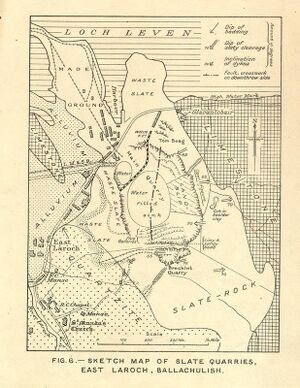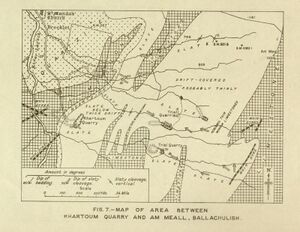East Laroch, Ballachulish slate belt, Scotland
| From: Richey, J.E. and Anderson, J.G.C. 1944. Scottish slates. Wartime pamphlet No. 40. London : Geological Survey of Great Britain. |
Maps


One inch to the mile (Geological: colour-printed) Sheet 53
Six inches to the mile: Argyll, Sheet 30 S.E.
General description
The Ballachulish Slates form an outcrop about a third of a mile wide at East Laroch, Ballachulish. Half a mile to the S. the outcrop narrows to 100 yds., between Ballachulish Limestone to E. and Appin Quartzite to W., and then joins up with another outcrop of the Slates which lies E. of the limestone. The slates then continue southwards for a considerable distance in a belt about half a mile wide.
The Main (Ballachulish) Quarry is situated immediately behind East Laroch village. Immediately south of this great excavation in the hillside, and separated from it by only a narrow barrier but lying on a different property, occurs the much smaller Brecklet Quarry. The latter lies higher than the Main Quarry, and its bottom corresponds with a level about halfway down the present face of the Main Quarry. Another small opening, called the Khartoun Quarry, is situated a little over half a mile farther S. on low ground adjoining the E. side of Gleann an Fhiodh.
Main (Ballachulish) Quarry
| Locality | On E. side of village of East Laroch, Ballachulish. |
| Access | Adjacent to main road, harbour and railway station. |
| Description of slate | Colour dark grey; surface even, but shows well-marked grain in places; texture medium. Phyrites (‘diamonds’) fairly abundant and of moderate size (? - 3/16 inches), sometimes concentrated along particular beds. |
| Dips, with amounts | Cleavage-dip, W. 25ºS. at 65º on N.E. side, W. 5ºS. at 70º on S.E. side. Bedding largely coincident with cleavage, except on S. side where the bedding is locally flat. |
| Joints | In addition to various haphazard fractures, there is a well-developed set of joints, often accompanies by incipient crushing, inclined S.E. at 25º-30º, especially on N.E. side of quarry. |
Details of workings
The quarry has the form of a large opening in the hillside, with a deep excavated sink, at present flooded, in the quarry floor. Its major dimensions are roughly 400 yds. From N. to S. and 280 yds. from E. to W. On the S. side, the lip of the quarry is some 300 ft. above floor-level, or 420 ft. above the bottom of the water-filled sink. The W. of the quarry is now practically entirely obscured by debris and part of the E. side by a great rock-fall 180 yds. across and from 200 to about 250 ft. high. The slip started some 40 years ago, but subsequent slips have occurred, the last in 1938. Since 1938 production has therefore been mainly from the southern and north-eastern parts of the quarry. On the S. side there are five well-defined galleries, the uppermost of which is separated from Brecklet Quarry to S. by only a narrow barrier; the third gallery is at about the level of the bottom on Brecklet Quarry. The N.E. side used to be worked in three galleries, but latterly only the bottom gallery has been in use, and the second level has been lost. Below general floor level there are other two galleries, totalling 120 ft., which are under water at the present time.
Five seams of especially good quality are known to occur, the most easterly of which is one the line of the rock-fall. While the main supply of commercial slate is concentrated in these seams, a fair proportion of slates is obtained from intervening slate-rock and from smaller seams. Seams of slate-rock, called the ‘oak’ variety, which is difficult to split unless a straight edge is obtained, occur along the N.E. side of the quarry. Thin brown-weathering limy beds occur in places, especially at the E. end of the top gallery where they are associated with sandy beds, as at the E. end of Brecklet Quarry. There are also veins of quartz, particularly near the centre of the quarry, some of which follow the cleavage. Near the entrance (N. side) of the quarry there is an inclined dyke of intrusive igneous rock (‘whin’), 6 ft. thick, dipping E. 25º S. at 30º, and so cutting across the cleavage. The slates sometimes have a poor cleavage in the immediate vicinity of the dyke, but the effect is purely local. Considerable surface creep has occurred in places and there is a fairly heavy overburden of boulder clay, etc. to S.E. (For details of method of working see Bailey 1916, pp. 230-231).
Reserves
The most natural long term development of the workings would appear to be eastwards and south-westwards, partly through or under the N.E. side of Brecklet Quarry which lies on another property, but mainly within the present lease-hold. It would appear that the difficulty presented by the great slip on the E. and S.E. face will have to be surmounted sooner or later. Account will have to be taken of a major gaping fissure some 40 ft. back from the present edge of the slip, as well as others nearby. Overburden increases for a space on either side of the leasehold boundary. Readily available reserves are those extending from the present N.E. face through the knoll known as Tom Beag.
Brecklet Quarry
| Locality | Immediately S. of Main (Ballachulish) Quarry. |
| Access | By track branching to E. off road up E. side of Gleann an Fhiodh 150 yds. S. of main road. |
| Description of slate | Colour dark grey; surface even, but shows well-marked grain in places; texture medium. Phyrites (‘diamonds’) fairly abundant and of moderate size (? - 3/16 inches), sometimes concentrated along particular beds. |
| Dips, with amount | Cleavage-dip, W. at 55º in western part, W. 15º S. at 70º in eastern part. Bedding-dip not determined in western part; appears to be coincident with cleavage in eastern part. |
| Joints | No general direction noted. |
Details of working
The quarry has been worked in two main levels. The lower is at present largely filled with debris and water. The upper level is narrow, and the top rock is locally bent and broken to a depth of 10 ft. Near the eastern end of this bench the slate-rock includes some limy sandy bands and is of poor quality.
Reserves
Large reserves exist to S. and to E.
Khartoum Quarry
| Locality | Three quarters of a mile S. of Each Laroch. |
| Access | By road and track up E. side of Gleann an Fhiodh. |
| Description of slate | Colour dark-grey; surface even, with well-marked grain in places; texture medium. Phyrites (‘diamonds’) fairly abundant, in diameter generally about ? inch but in some cases up to ¼ inch. |
| Dips, with amounts | Cleavage-dip, N.W. at 70º. Bedding-dip, not determined with certainty but appears to be largely coincident with cleavage. |
| Joints | Several joints, along some of which movement and local mineralization (formation of pyrites) have taken place, dip S.S.E. at about 15º. |
Details of workings
The quarry has the form of an opening with 3- ft. Walls, and with the entrance at S.W. end, extending along the strike of the cleavage for some 90 yds. It is generally about 16 yds. wide, but has been extended across the strike near the S.E. corner for a further 15 to 20 yds. There is a water-filled sink in the floor up to 20 ft. deep. Overburden of clayey moraine is 6 to 12 ft. thick; the top rock is bent and broken to a depth of 5 ft.
Reserves
To N.W. and W. of the quarry-entrance quartzites should soon be encountered. To the E. there is a broad outcrop of slates, but many limy bands which occur about 100 yds. from this end of the quarry might hinder development beyond this distance. Expansion is also possible to N.E., although the overburden is heavy and may locally by fully 15 ft. thick. To S.W. some slate rock might be wrought for a short distance; in this direction the ground falls away towards a stream.
Possible area for new development
| Locality | Hillside, where trial quarries are shown in (P519819) , between ¼ and ½ ml. E. of Khartoum Quarry and extending from there north-eastwards for half a mile. |
| Access | An access road would have to be made up hillside from track leading to Khartoum Quarry. |
| Description of slate | As far as is known, the slate-rock is similar to that in the Main Quarry. |
| Dips, with amounts | In the lower part of the hillside, ¼ mile E. of Khartoum Quarry, the cleavage dips E.S.E. at 70º. Farther E., 1/3 to ½ ml. E. of the quarry, it dips W.N.W. at 70º. |
| Joints | Owing to lack of suitable exposures no general direction of joints was noted. |
Description of area
Exposures of the slate are confined to a few trial pits and to sections along streams. In all of these, slate of good quality can be observed forming seams of varying breadth interbanded with poorer material. The top rock is locally bent and broken, although not to an excessive depth. Overburden is generally present but is probably everywhere of moderate thickness.
Reserves
The area is limited to W. by the limestone bands which lie not far E. of Khartoum Quarry and to E. by similar bands occurring near a major outcrop of the Ballachulish Limestone. Between these two calcareous zones there is a belt of slate, about 300 yds. wide, which appears to be free from limy bands. Reserves within this belt, which, once opened up, could be worked probably for upwards of half a mile to N.E., are very great.